Heights Deserve a Driller’s Respect
When Necessary, Use PFA Devices to Minimize Fall Risks

A built-in ladder certainly makes work at height on a mast easier, but it doesn’t eliminate the need for proper fall-arrest gear.
Source: Greg Goebel / CC BY-SA 2.0 / Wikimedia Commons
You would never catch me shinnying up a drill mast. I liked climbing trees as a kid, but since then free climbing and I have parted ways. Mind you, I’m not paralyzed-in-a-corner scared of heights. I’ve walked the glass-floored observation deck of the CN Tower and looked out over Manhattan from the top of One World Trade. But, when it comes to putting the cap back on my chimney after it blows off in a storm, I call someone.
I respect heights and so should you. In this issue, Safety 365 columnist Dave Bowers affirms that respect. He builds on last month’s column making the case for fall protection in circumstances that call for it. This month, he explains the requirements and features of various personal fall-arrest devices. His column gives me the opportunity to do something I could not have this time last year: Tell you to go watch video in an issue of the magazine. Bowers submitted demo videos of various types of PFAs and we paired them with his column in this issue. Click over to see them.
Now, I hear stories about people thumbing their nose at safety all the time. Maybe they leave the hardhat in the truck or they macho themselves into lifting more than they should. Maybe, as Bowers talked about last month, they free-climb a drill mast without a second thought.
People cavalier about safety might act differently if they saw what could happen. Everyone should watch these demo videos. They show what happens to a weighted dummy during a typical fall. If anything, they make a strong argument for using the best PFAs money can buy. In one video, with an ill-fitting harness and basic PFA device, the dummy bounces violently when the fall finally arrests. That kind of snap-back would break me in two. Even the hardiest of us, Bowers says, can spend weeks in the hospital after an arrested fall. But, that’s nothing compared to hitting the ground.
That brings me back to my first point: having a healthy response to heights. As an office guy with an elevated sense of self-preservation, that means having a handyman with an extension ladder on speed dial. For drillers and other construction workers who may have to work at height, it means:
- Deciding whether the work at height is actually required, or whether there’s a safer way to do it than climbing (e.g., lowering the mast).
- Making a plan for that work that minimizes the risk involved.
- Executing that plan with the best available safety equipment.
Watch the video with the basic tether and ill-fitting harness again. (Heck, it’s only 6 seconds. Watch it another 10 times, and that would be just a minute of your life.) Burn it into your head. Think of it every time you consider free climbing for expediency’s sake. Think of it every time you imagine the hassle of properly getting your harness “just right.” Think of it, and remember that bouncing dummy could be you headed toward a two-week stay in the hospital. But, you’d still be better off than the dummy who didn’t wear his PFA and hit the ground.
What do you think? Have you had a close call with a fall that made you rethink PFAs? Do you know someone who got hurt in a fall? Let me know. Send an email to verduscoj@bnpmedia.com.
Stay safe out there, drillers.
Working on an interesting project or have industry wisdom to share? Email verduscoj@bnpmedia.com to be considered for a guest spot on Drilling In-Site.
Looking for a reprint of this article?
From high-res PDFs to custom plaques, order your copy today!




